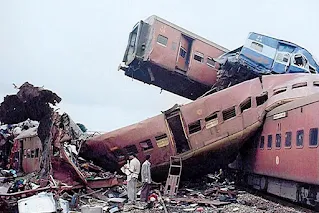The Gaisal train disaster occurred on August 2, 1999, in Gaisal, a small town located in the northeastern Indian state of Assam. This tragic event ranks among the deadliest railway accidents in the history of India. The incident involved a collision between two trains, the Brahmaputra Mail and the Awadh-Assam Express, resulting in a high number of casualties and injuries.
 |
| Gaisal Train Disaster: A Tragic Collision That Shook India's Railway System |
The day started like any other for the passengers traveling on these trains. The Brahmaputra Mail was on its way from New Delhi to Dibrugarh, while the Awadh-Assam Express was en route from Guwahati to New Delhi. Both trains were carrying a significant number of passengers, as is typical for long-distance journeys in India. At approximately 2:30 am, near the Gaisal Railway Station, a tragedy unfolded. Due to a signaling error, both trains were directed onto the same track, leading to a head-on collision. The impact was devastating, causing several coaches to derail and catch fire, trapping many passengers inside. The collision and subsequent fire resulted in a large number of fatalities and severe injuries. News of the accident spread rapidly, and rescue operations were immediately initiated. Local authorities, railway officials, and emergency services rushed to the scene to assist the injured and extract survivors from the wreckage. The injured were quickly transported to nearby hospitals for medical treatment, while efforts were made to identify the deceased and notify their families. The Gaisal train disaster was a harrowing incident, claiming the lives of 290 individuals and leaving hundreds more injured. The scenes of destruction and chaos were heartbreaking. Railway authorities faced immense challenges in dealing with the aftermath of the accident, including identifying the victims, providing support to their families, and investigating the causes of the collision. In the wake of the disaster, there was an outcry for improved safety measures and stricter enforcement of railway regulations in India. The incident shed light on the vulnerabilities within the Indian Railways' infrastructure and the need for comprehensive reforms. The focus shifted toward modernizing signaling systems, enhancing safety standards, and investing in the overall maintenance and upkeep of railway tracks and rolling stock. Since the Gaisal train disaster, the Indian Railways has taken steps to address these concerns. Various measures have been implemented to improve safety, such as the installation of advanced signaling systems, the use of technology to monitor train movements, and the introduction of safety audits and inspections. Additionally, efforts have been made to enhance emergency response capabilities and train railway personnel in disaster management. Despite these efforts, train accidents continue to occur in different parts of India, underscoring the ongoing challenges faced by the Indian Railways. The sheer size and complexity of the railway network, coupled with the increasing demands of passenger and freight transportation, necessitate sustained efforts to ensure the safety and security of passengers and staff. In conclusion, the Gaisal train disaster was a tragic event that occurred in 1999, resulting in the loss of numerous lives and injuries. The collision between the Brahmaputra Mail and the Awadh-Assam Express exposed the shortcomings in railway safety measures in India. Although significant strides have been made in improving safety standards since then, continued efforts are required to prevent such accidents and safeguard the lives of passengers and railway personnel.
Tags:
Gaisal train disaster